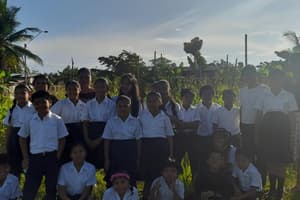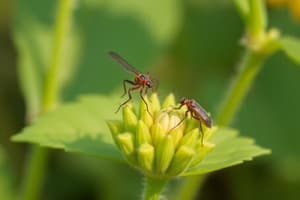Podcast
Questions and Answers
Which strategy exemplifies regulatory control by focusing on preventing the entry of pests into a new area?
Which strategy exemplifies regulatory control by focusing on preventing the entry of pests into a new area?
- Prevention of pest entry specifically targeting quarantine pests. (correct)
- Eradication of regulated non-quarantine pests that are already present.
- Containment strategies to limit the spread of pests to adjacent regions.
- Suppression of established pest populations through habitat modification.
How does a 'regulated non-quarantine pest' differ from a 'quarantine pest' under regulatory control strategies?
How does a 'regulated non-quarantine pest' differ from a 'quarantine pest' under regulatory control strategies?
- A regulated non-quarantine pest is subject to less stringent control measures.
- A regulated non-quarantine pest is targeted for eradication, while quarantine pests are managed through containment.
- A regulated non-quarantine pest poses no economic threat, unlike quarantine pests.
- A regulated non-quarantine pest is present in the area, while a quarantine pest is not. (correct)
Why is Pest Risk Analysis (PRA) considered a critical component of regulatory control?
Why is Pest Risk Analysis (PRA) considered a critical component of regulatory control?
- It evaluates scientific and economic evidence to decide if a pest should be regulated and the strength of measures needed. (correct)
- It solely assesses the biological characteristics of pests without considering economic factors.
- It primarily focuses on the economic impacts of trade restrictions due to pest outbreaks.
- It is used to determine the political implications of controlling a specific pest.
How does international quarantine law, specifically the FAO-IPPC on SPS Agreement, contribute to pest management on a global scale?
How does international quarantine law, specifically the FAO-IPPC on SPS Agreement, contribute to pest management on a global scale?
What is the primary goal of domestic quarantine laws issued by local governments in the context of pest management?
What is the primary goal of domestic quarantine laws issued by local governments in the context of pest management?
What distinguishes an 'eradication program' from a 'containment program' in the regulatory control of non-quarantine pests?
What distinguishes an 'eradication program' from a 'containment program' in the regulatory control of non-quarantine pests?
In the context of biological control, what is the crucial distinction between 'natural control' and 'biological control'?
In the context of biological control, what is the crucial distinction between 'natural control' and 'biological control'?
How does an 'inoculative release' of a biocontrol agent differ from an 'inundative release' in biological pest control strategies?
How does an 'inoculative release' of a biocontrol agent differ from an 'inundative release' in biological pest control strategies?
What is a primary limitation to the widespread adoption of biological control methods in pest management?
What is a primary limitation to the widespread adoption of biological control methods in pest management?
From a strategic perspective, what is the primary aim of autocidal control methods in pest management?
From a strategic perspective, what is the primary aim of autocidal control methods in pest management?
What is a critical factor for the success of the Male Sterile Technique in autocidal pest control?
What is a critical factor for the success of the Male Sterile Technique in autocidal pest control?
How does 'Behavioral Control' in pest management primarily reduce pest populations?
How does 'Behavioral Control' in pest management primarily reduce pest populations?
How do chemical attractants function in behavioral pest control strategies?
How do chemical attractants function in behavioral pest control strategies?
What is the primary focus of biotechnology in the context of agricultural pest control?
What is the primary focus of biotechnology in the context of agricultural pest control?
What is a significant environmental risk associated with the use of genetically modified organisms (GMOs) in pest control?
What is a significant environmental risk associated with the use of genetically modified organisms (GMOs) in pest control?
What is a key consideration in safety checks for GMOs before their commercial release?
What is a key consideration in safety checks for GMOs before their commercial release?
What is a central mechanism of 'antixenosis' in host plant resistance (HPR)?
What is a central mechanism of 'antixenosis' in host plant resistance (HPR)?
How does 'induced resistance' function as a mechanism in Host Plant Resistance (HPR)?
How does 'induced resistance' function as a mechanism in Host Plant Resistance (HPR)?
What is a limitation of host plant resistance (HPR) concerning resistant cultivar development?
What is a limitation of host plant resistance (HPR) concerning resistant cultivar development?
What is a crucial strategy for managing the breakdown of resistance in host plant resistance (HPR)?
What is a crucial strategy for managing the breakdown of resistance in host plant resistance (HPR)?
Why is the use of an untreated 'refuge' considered essential in resistance management for transgenic crops like Bt corn?
Why is the use of an untreated 'refuge' considered essential in resistance management for transgenic crops like Bt corn?
In addition to direct toxicity to target pests, what is another potential disadvantage associated with transgenic crops expressing Bt toxins?
In addition to direct toxicity to target pests, what is another potential disadvantage associated with transgenic crops expressing Bt toxins?
What is a key requirement for the effective use of cultural control methods in pest management?
What is a key requirement for the effective use of cultural control methods in pest management?
In physical pest control, how does solarization work to reduce pest populations in the soil?
In physical pest control, how does solarization work to reduce pest populations in the soil?
Flashcards
Pest Control Methods/Tactics
Pest Control Methods/Tactics
Specific techniques to reduce pest populations or their damage to crops.
Theoretical Basis of Control
Theoretical Basis of Control
Aim to affect ecological processes influencing the population.
Regulatory Control (Pests)
Regulatory Control (Pests)
Legislative and legal actions to prevent pest entry, establishment, and spread.
Pest Risk Analysis (PRA)
Pest Risk Analysis (PRA)
Signup and view all the flashcards
Quarantine Protocol Aims
Quarantine Protocol Aims
Signup and view all the flashcards
Eradication Program
Eradication Program
Signup and view all the flashcards
Containment Program
Containment Program
Signup and view all the flashcards
Suppression Program
Suppression Program
Signup and view all the flashcards
Biological Control (Biocon)
Biological Control (Biocon)
Signup and view all the flashcards
Natural Control
Natural Control
Signup and view all the flashcards
Biological Control
Biological Control
Signup and view all the flashcards
Natural Enemy
Natural Enemy
Signup and view all the flashcards
Biocon Agent (BCA)
Biocon Agent (BCA)
Signup and view all the flashcards
Parasite
Parasite
Signup and view all the flashcards
Parasitoid
Parasitoid
Signup and view all the flashcards
Predator
Predator
Signup and view all the flashcards
Pathogens
Pathogens
Signup and view all the flashcards
Autocidal Control
Autocidal Control
Signup and view all the flashcards
Behavioral Control
Behavioral Control
Signup and view all the flashcards
Chemical Attractants
Chemical Attractants
Signup and view all the flashcards
Repellents
Repellents
Signup and view all the flashcards
Biotechnological Control
Biotechnological Control
Signup and view all the flashcards
Cultural Control
Cultural Control
Signup and view all the flashcards
Physical & Mechanical Control
Physical & Mechanical Control
Signup and view all the flashcards
Host Plant Resistance (HPR)
Host Plant Resistance (HPR)
Signup and view all the flashcards
Study Notes
Non-Pesticide Pest Control Introduction
- Pest control methods/tactics are specific techniques to reduce pest populations or their impact on the crop.
- These tactics are grouped by the form/manner of the control agent used.
- The module focuses on non-pesticide control, emphasizing biological control.
Theoretical Basis of Control
- Control tactics target ecological processes affecting a pest population.
- Tactics enhance mortality, reduce natality, prevent immigration, hasten emigration, and/or retard growth and development.
- These tactics manipulate/introduce elements (natural enemies, crop types) into the pest's environment.
Regulatory Control (Legislative/Legal)
- All legislation/regulation preventing pest entry, establishment, and spread; involves legal/regulatory actions to control pests.
- Aims to prevent entry/establishment of foreign pests and/or eradicate/suppress established pests via legal means.
Strategies For Regulatory Control
- Prevent pest entry by quarantining pests.
- Eradicate regulated non-quarantine pests
- Contain the spread
- Suppress population numbers.
Quarantine vs Regulated Pests
- Quarantine pests are not present in an area
- Regulated non-quarantine pests are present in an area.
- Pest Risk Analysis (PRA) determines if a pest should be regulated.
Pest Risk Analysis (PRA)
- PRA evaluates biological, scientific, and economic evidence.
- PRA determines if a pest should be regulated and the strength of phytosanitary measures.
- Defined by FAO, IPPC, evidence includes pest biology/ecology, economic impacts, and political implications.
PRA Stages
- Stage 1 (Initiation): Identify target pests and entry pathways.
- Stage 2 (Pest Categorization & Risk Assessment): Determine quarantine status, assess the risks of introduction/spread, and assess potential economic consequences.
- Stage 3 (Risk Management): Determine actions to handle risks.
Types of Quarantine Laws
- International: FAO-IPPC on SPS Agreement.
- Domestic: Congress, Department of Agriculture, and local government issuance.
Quarantine Protocol Aims
- Establish pest barriers and restrict movement to reduce pest introduction risks.
- Inspect goods at the point of origin (quarantine certification), point of entry, or in high-risk zones via field monitoring/surveys.
- Actions include returning goods to the origin or destroying them.
Philippine Quarantine System
- Plant Quarantine Division of the Bureau of Plant Industry is under the Department of Agriculture.
- Conducts PRA for imported agricultural products and issues Phytosanitary Certifications for import/export.
- Governed by Presidential Decree No. 1433 (1978), Republic Act 3027, and Republic Act 3767 (1930).
Regulatory Control of Non-Quarantine Pests
- Eradication programs eliminate newly introduced pests in a geographic area
- Containment Programs prevent the spread of introduced pests that cannot be eradicated
- Suppression Programs suppress sudden pest outbreaks over wide areas
Quarantine/Regulation in the Philippines
- Lists pests declared under quarantine/regulation, including pathogens like Papaya Ringspot Virus, Citrus Greening, and Mango Malformation of Bunchy-top.
Biological Control (Biocon)
- Biocontrol is the control of plant pests by living organisms under natural or artificial circumstances.
- Natural control is mortality factors without human intervention.
- Biological control manipulates natural enemies to control pests
Natural Enemy vs Biocon Agent (BCA)
- Natural enemies are naturally-occurring populations.
- Biocon agents are mass-produced populations released into the environment.
Biocontrol Advantages
- Alternatives to pesticides and tools for resistance management.
- Pollution or risk-free pest control with promotion of biological balance and more permanent solutions
- Safe and cheap for pest problems
Types of Biocontrol Agents Against Arthropod Pests
- Parasites do not kill the host and all life stages are dependent on host
- Parasitoid Kills the host and has a free-living stage in the life cycle
Pathogens
- Disease causing microoganisms:
- Bacteria
- Actinomycetes
- Fungi
- Viruses
- Nematodes
Characteristics of Good Biocontrol Agent
- Good Biocontrol Agents are generally stable, effective at low concentrations, in-expensive, and effective against a wide range of pests.
- These agents are also non-toxic to humans, resistant to pesticides, non-pests pathogenic to the crop, and compatible with cultural practices.
Approaches to Biological Control
- Applied preemptively before the pest problem is intense
- Applied reactively when pest problems are severe
- Introduction of new species
- Conservation (do nothing/modification of environment)
- Augmentation (artificial release)
Delivery of Biocontrol Agents
- Release (augmentation/inundation)
- Spraying
- Soil drenching
- Seed treatment
- Dipping planting materials/fruits
Reasons for Slow Adoption of Biological Control
- BCAs (biocontrol agents) are slow acting
- Pesticides are popular as they are fast acting and spectacularly effective.
Autocidal Control
- Autocidal Control involves tactics that cause pests to contribute to their destruction,
- Technique is ingenious and highly publicized
Advantages of Autocidal Control
- The effect can be exerted in untreated individuals of interbreeding population
- The effect is rapid
- There is a lack of biological defense
Types of Autocidal Control
- Male Sterile Technique
- Sterile releases into the population
- Sterile male insects compete with fertile female
- Reduces rate of reproduction
Essential factors for success of Male Sterile Technique
- The area of release must be geographically isolated
- Sterile male must be sexually competitive
- The pest must be amenable to laboratory rearing
- It must have an extremely large budget.
Genetic Control
- Decreases the ecological fitness of pest species by introducing lethal genes into the population.
Behavioral Control
- Tactics affect pest behavior, reducing pest populations using:
- Chemical Attractants
- Repellents
Chemical Attractants
- Chemicals cause insects to make oriented movements towards the source (pheromones like Lure for Trap)
Chemical Attractants Utilies
- Detection and survey
- Direct pest control
- Alteration of normal behavior
Repellents
- Chemicals cause insects to make oriented movement away from its source
- Used for the protection of domestic animals and Humans
Biotechnological Control Defined
- Bios (life) + technology (product of science)
- It uses living organisms to improve quality and enhance quality
Benefits of Crop Protection Under Biotechnological Control
- Improved effectiveness of biocontrol agents and improves enivornmental quality
- Monitoring and detection capabilities ELISA (monoclonal antibodies,cDNA probe,PCR,Etc.)
- Improved Pest tolerance of crop through Bt corn, protein coat mediated resistance, and plants with cutinase
Disadvantages of Biotechnological Control
- Toxicity of gene products like Bt corn
- Risk of Environmental risk:
- GMOs becoming pests
- Gene transfer to related species
- Displacement of indigenous flora
- Loss of diversity
Safety Checks for GMO
- A case-by-case assessment must be done before commercial release to assess benefits and impact
- Environmental safety impact non-living and living components
Host Plant Resistance (HPR)
- The ability of a plant to withstand or overcome pest attacks, leading to lesser damage or effects on yield quality.
- Resistance is based on morphology, behavior and physiology
Mechanisms of Plant Resistance
- Host Evasion and Resistance is dependant on Mechansisms in HPR
- "Host Escape" has geographical or meteorological barriers i.e soil is not conducive to plant pathogen
- Induced Resistance has a plant defense initiated by attacks of pests by production of anti-microbial or anti-pest substances
Antixenosis
- Deters pests before colonization
- Prevent pests from attacking host plant
- Causing Insects to starve,refuse to oviposit on resistant plant
- Chemical - Attractive chemicals are absent
- Morphological - Hairs/Pubescence deters leafhoppers
Insect components for host resistance
- Host habitat finding and host finding uses volatile chemicals (semiochemicals such as silhouettes)
- Host recognition
- Host acceptance uses tactile characteristcs and chemical exudates
Plant resistance factors
- Plant structures, textures, and tastes
- Nutrition and quality
Altering for more insects resistant
- Succelence, toughness, hairs, spines. thorns - Colors and Shape - Secondary metabolites - Chemical factors - Enzymes, hormones, carbohydrates, lipids, proteins and phosphorous compounds Primary metabolites
Abiosis
- Toxic Metabolites
- Absence of Nutrients
- HPR Mechanisms
- Inhibitory
Tolerance Characteristics
- Longer developments
- Production of critical metabolites
- Presence to toxins( nicotine)
- Deterrents( silica)
Immunity
- Total resistance
- Applicable to pathogens
Factors Influencing Expression of HPR Mechanisms
- Temperature
- Soil fertility
- Soil PH
Genetic Basis of Resistance
- Single-gene based vertical resistance and "all or nothing effect"
Host Resistance in Plant Diseases
- Race specific or susceptible(vertical)
- Exhibit tow or moderate resistance(Horizontal)
HPR Importance
- Reduces pesticides used
- Least expenses
- Singularly effectiv
HPR Development
- Use of hybrids or genetic engineering
Cultural Control
- Suppression using cutltural practice
- Normally used for growing crops
Advantages of Cultural Control
- Effective and cheap
- Comaptible with other methods
Disadvantages of Cultural Control
- Provides effective control
Requirements for Cultural Control
- Requires crop phenology
- Pest ecology
- Pest biology and life cycle
Other Methods for Cultural Control
- Combination
- Reducing pest reproduction
- Reduce intital infection
Studying That Suits You
Use AI to generate personalized quizzes and flashcards to suit your learning preferences.





